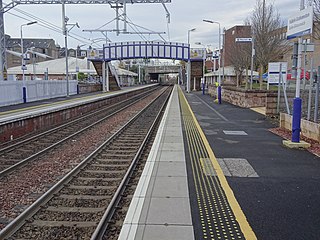
Falkirk Grahamston railway station is one of two railway stations serving the town of Falkirk in Scotland. It is located on the Edinburgh to Dunblane Line and also the Cumbernauld Line. Train services are provided by ScotRail. The "Highland Chieftain", the daily London North Eastern Railway service from London King's Cross to Inverness and vice versa also calls here.
The Carnarvonshire Railway was a railway connecting Caernarvon railway station with Afon Wen.
The Ruabon–Barmouth line was a standard-gauge line owned by the Great Western Railway across the north of Wales which connected Ruabon, in the east, with Barmouth on the west coast.
The Perth, Almond Valley and Methven Railway was a Scottish railway line that connected Methven with Perth. It opened in 1858.
The Crieff and Methven Junction Railway was a Scottish railway, opened in 1866, connecting Crieff with a branch line that ran from Methven to Perth.
The Bathgate and Coatbridge Railway, also known as the "New Monkland Line", was built by Monkland Railways. It opened on 28 July 1863. The line was absorbed into the Edinburgh and Glasgow Railway on 31 July 1865. The following day, the line became part of the North British Railway.
The Glasgow and Renfrew District Railway was nominally owned by the Glasgow and Paisley Joint Railway. It was incorporated on 6 August 1897 and opened on 1 June 1903.
The Caledonian and Dumbartonshire Junction Railway (C&DJR) was a Scottish railway opened in 1850 between Bowling and Balloch via Dumbarton. The company had intended to build to Glasgow but it could not raise the money.
The Forth and Clyde Junction Railway was a railway line in Scotland which ran from Stirling to Balloch.
The Glasgow to Aberfoyle Line was a railway line in Scotland, built in stages, leaving the Edinburgh and Glasgow Railway near Lenzie. Tourist traffic was a dominant part of the motivation for building the line, and road tours to the Trossachs from Aberfoyle formed a significant part of the traffic.

Bowling railway station was a railway station located in the village of Bowling, Scotland, on the Lanarkshire and Dunbartonshire Railway.
The Hamiltonhill Branch was constructed by the Caledonian Railway in 1894 with the intention to provide a large goods yard at Hamiltonhill on the Forth and Clyde Canal. There was also a branch to the Saracen Foundry but this had to be closed as it was in breach of an agreement with the North British Railway.
The Glasgow, Dumbarton and Helensburgh Railway was independently sponsored to build along the north of the River Clyde. It opened in 1858, joining with an earlier local line serving Balloch. Both were taken over by the powerful North British Railway in 1865, and for some time the line was the main route in the area. As industry developed other lines were opened to serve it, and the line formed the core of a network in the area.

Aberfoyle railway station served the village of Aberfoyle in Scotland between 1882 and 1951.
The Border Union Railway was a railway line which connected places in the south of Scotland and Cumberland in England. It was authorised on 21 July 1859 and advertised as the Waverley Route by the promoters - the North British Railway. It connected the Edinburgh and Hawick Railway at Hawick with Carlisle.

Balfron railway station was a railway station that served the village of Balfron in Scotland. The station was served by trains on the Strathendrick and Aberfoyle Railway and the Forth and Clyde Junction Railway, both of which closed in the 1950s.

The Blane Valley Railway was a railway line in Scotland to the east of Glasgow. It is now closed. In 1891 the railway company was absorbed by the North British Railway, which had operated the line and been a major shareholder from the start. When NBR took over the line was in a poor state. The goods shed was inadequate for the amount of traffic, the only crane was too small and siding accommodation was deficient. There was considerable potential for the transportation of cattle in the area but there were no facilities in place. Capital was invested and the line transformed. The locomotives were cleaned and the stations given a makeover. Close attention was given to the cleanliness of staff and the neatness of their uniforms. The railway was the only means of transport for the people living in the area and was a source of much pride. In 1923 following the grouping it became part of London and North Eastern Railway. Following nationalisation in 1947, it was taken over by British Railways. Unable to compete in the face of road competition, the line was closed to passengers in 1951 and closed completely in 1959.
The Glasgow, Bothwell, Hamilton and Coatbridge Railway was a railway company in Scotland, built to serve coal and ironstone pits in the Hamilton and Bothwell areas, and convey the mineral to Glasgow and to ironworks in the Coatbridge area. It was allied to the North British Railway, and it opened in 1877. Passenger services followed.

Dumgoyne railway station served the village of Killearn, Stirling, Scotland from 1867 to 1951 on the Blane Valley Railway.
Killearn railway station served the village of Killearn, Stirling, Scotland from 1882 to 1951 on the Blane Valley Railway.





